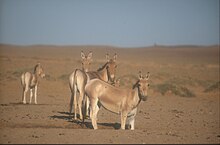Mongolian wild ass
| Mongolian wild ass | |
|---|---|
 |
|
| Mongolian wild asses in the Gobi Desert, Mongolia. | |
| Scientific classification | |
| Kingdom: | Animalia |
| Phylum: | Chordata |
| Class: | Mammalia |
| Order: | Perissodactyla |
| Family: | Equidae |
| Genus: | Equus |
| Species: | E. hemionus |
| Subspecies: | E. h. hemionus |
| Trinomial name | |
|
Equus hemionus hemionus Pallas, 1775 |
|
| Synonyms | |
|
Equus (Asinus) hemionus bedfordi Matschie 1911 |
|
Equus (Asinus) hemionus bedfordi Matschie 1911
Equus (Asinus) hemionus findschi Matschie 1911
Equus (Asinus) hemionus luteus Matschie 1911
The Mongolian wild ass (Equus hemionus hemionus), also known as Mongolian khulan is the nominate subspecies of the onager. It is found in Mongolia and northern China, and was previously found in eastern Kazakhstan and southern Siberia before being extirpated there through hunting. Previously in 2003, there were an estimated population of less than 20,000 individuals. In 2009, the Mongolian wild ass population had decreased to 14,000 total individuals.
In 2015, the Mongolian wild ass are listed as Near Threatened by the IUCN and it is also estimated that there are 23,000 mature individuals in total.
The Mongolian wild ass may be synonymous with the possible proposed separate subspecies, the Gobi khulan (Equus hemionus luteus), also called the chigetai, dziggetai or simply khulan, Mongolian: Хулан.
The Mongolian wild ass, like most Asiatic wild asses, lives in deserts, cold deserts, steppes, shrublands and mountains. The Gobi Desert is the subspecies' main stronghold. It may also be found at the Altai Mountains.
The Mongolian wild ass is the most widespread subspecies, although despite that, the subspecies lost about 50% of its former distribution range in Mongolia in the past 70 years. The former range of the Asiatic wild ass in East Asia between the seventeenth and the middle of the nineteenth century encompassed the greater part of Mongolia, areas of Siberia and Manchuria, the western part of Inner Mongolia and the northern part of Xinjiang. Its distribution range then dramatically reduced during the 1990s. A 1994–1997 survey estimated its population size at 33,000 to 63,000 individuals over a continuous distribution range encompassing all of southern Mongolia. In 2003, a new survey found approximately 20,000 individuals over an area of 177,563 square kilometres (68,557 sq mi) in southern Mongolia. The species had decreased to 14,000 individuals in 2009. The population estimates of the Mongolian population should be treated with caution due to a lack of proven survey protocols.
...
Wikipedia

